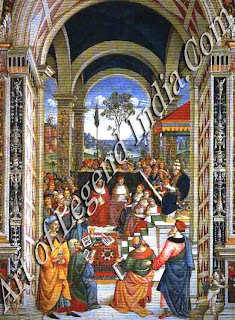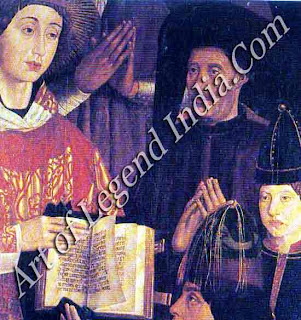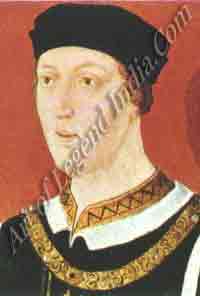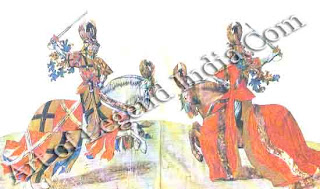
A Year in the Life 1460
As the
Ottoman Turks drove remorselessly into Europe, Piero's patron, the humanist
Pope Pius II, appealed to little effect, for a crusade to save Christendom.
Meanwhile the sovereigns of Europe remained absorbed in chivalric dreams and
their inevitable dynastic struggles.
In 1458
Aeneas Silvius, the former poet, humanist, and diplomat, was elected to the
papal chair as Pius II. Though determined to steer his own course and renounce
his earlier frivolities, the new pontiff was still sufficiently a man of the
Renaissance to order Piero della Francesca to Rome to decorate his apartments.
The artist was paid 150 florins 'for his share of the work on paintings carried
out on his Holiness' bedroom'.
Pius
took his new role extremely seriously. In 1460 he issued the papal bull
Execrabilis which condemned as heretical all those who felt that they could
legitimately appeal to a general council over the head of the pope. Papal
authority was to remain supreme in all church matters.
 Pius
was also obsessed with the dream of rallying Christendom under the papal banner
to a crusade against the Ottoman Turks. In a century and a half this small
Islamic group had become the most powerful political force in the Near East.
Only seven years before, they had conquered Constantinople, and brought the
1000-year-old Byzantine Empire to an end. In 1460 they captured the Morea (the
great peninsula that constitutes Southern Greece), and murdered the last duke
of Athens, Franco Acciajuoli. The Turks were now poised for European conquest.
Pius
was also obsessed with the dream of rallying Christendom under the papal banner
to a crusade against the Ottoman Turks. In a century and a half this small
Islamic group had become the most powerful political force in the Near East.
Only seven years before, they had conquered Constantinople, and brought the
1000-year-old Byzantine Empire to an end. In 1460 they captured the Morea (the
great peninsula that constitutes Southern Greece), and murdered the last duke
of Athens, Franco Acciajuoli. The Turks were now poised for European conquest.
PAPAL DREAM SHATTERED
The
Pope had convened the Council of Mantua in June 1459, to which were summoned
the secular princes of Europe, in order to discuss plans for mobilization
against the Turkish menace.
Many
absented while others made flowery but evasive speeches. By February 1460 the
disillusioned Pope had dissolved the congress. Only the maritime commercial
republic of Venice was willing to fight but then Venice ruled extensive
territories in the Aegean.
During
this year the Venetians equipped their famous Arsenal with new doors, crowned
by the Lion of St Mark, the symbol of the city, but the book the lion carried
usually open, and inscribed 'Peace be with you, Mark was closed. The city of
merchants was preparing for war. Four years later Pius II died, on the brink of
leading the Crusade he had dreamed about. Venice was left to conduct a
punishing war single-handed against the Turks.
Although
the age of the crusades was over, the chivalric Ideal was still alive,
enshrined in the romances and ritual of French courtly life. Rene of Anjou,
sometimes called 'the last of the troubadours' had by 1460 begun his 'Livre des
Tournois', an illuminated book of chivalric ceremonial.
Rene's
daughter Margaret had already shown herself to be an Amazon of whom no
troubadour could possibly approve. As wife of the weak Henry VI of England -
she had emerged as the effective leader of the Lancastrian party in the Wars of
the Roses. 1460 was a year of changing fortunes, marked first by the
recognition of the Duke of York as Henry's heir, and then by the defeat and
death of York by disaffected Lancastrians at the Battle of Wakefield on 30
December.
 The
able and ruthless King of Scotland, James II, decided to take advantage of this
chaotic situation. The desirable English stronghold of Roxbrugh in the north
was held by the Yorkists with the result that James became a temporary
Lancastrian and laid siege to it during the summer of 1460. With the help of
artillery, the Scots took and utterly destroyed the Castle but James did not
live to see his victory. During a bombardment, while the King was keenly
watching this display of modem technology, one of the guns exploded and killed
him.
The
able and ruthless King of Scotland, James II, decided to take advantage of this
chaotic situation. The desirable English stronghold of Roxbrugh in the north
was held by the Yorkists with the result that James became a temporary
Lancastrian and laid siege to it during the summer of 1460. With the help of
artillery, the Scots took and utterly destroyed the Castle but James did not
live to see his victory. During a bombardment, while the King was keenly
watching this display of modem technology, one of the guns exploded and killed
him.
In the
long run, Scotland benefited more from events in northern Europe. In March 1460
Christian I of Denmark was recognized as Duke of Holstein and Count of
Schleswig. Paying off rival claimants to these titles crippled the Danish
exchequer. Thus the Scots eventually collected an unpaid dowry from the Danes
in territories instead of cash. In 1472 the Orkney and Shetland islands were
formally acceded to the Scottish crown.
Writer
– Marshall Cavendish

 Pius
was also obsessed with the dream of rallying Christendom under the papal banner
to a crusade against the Ottoman Turks. In a century and a half this small
Islamic group had become the most powerful political force in the Near East.
Only seven years before, they had conquered Constantinople, and brought the
1000-year-old Byzantine Empire to an end. In 1460 they captured the Morea (the
great peninsula that constitutes Southern Greece), and murdered the last duke
of Athens, Franco Acciajuoli. The Turks were now poised for European conquest.
Pius
was also obsessed with the dream of rallying Christendom under the papal banner
to a crusade against the Ottoman Turks. In a century and a half this small
Islamic group had become the most powerful political force in the Near East.
Only seven years before, they had conquered Constantinople, and brought the
1000-year-old Byzantine Empire to an end. In 1460 they captured the Morea (the
great peninsula that constitutes Southern Greece), and murdered the last duke
of Athens, Franco Acciajuoli. The Turks were now poised for European conquest.  The
able and ruthless King of Scotland, James II, decided to take advantage of this
chaotic situation. The desirable English stronghold of Roxbrugh in the north
was held by the Yorkists with the result that James became a temporary
Lancastrian and laid siege to it during the summer of 1460. With the help of
artillery, the Scots took and utterly destroyed the Castle but James did not
live to see his victory. During a bombardment, while the King was keenly
watching this display of modem technology, one of the guns exploded and killed
him.
The
able and ruthless King of Scotland, James II, decided to take advantage of this
chaotic situation. The desirable English stronghold of Roxbrugh in the north
was held by the Yorkists with the result that James became a temporary
Lancastrian and laid siege to it during the summer of 1460. With the help of
artillery, the Scots took and utterly destroyed the Castle but James did not
live to see his victory. During a bombardment, while the King was keenly
watching this display of modem technology, one of the guns exploded and killed
him. 












0 Response to "Italian Great Artist Piero Della Francesca - A Year in the Life 1460 "
Post a Comment